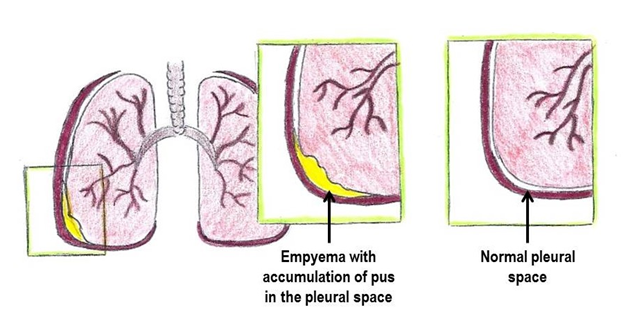Pulmonary Empyema
What is Pulmonary empyema?
Pulmonary empyema is a buildup of pus in the pleural space (space between the lung and chest wall). It is a complication of bacterial pneumonia when the bacteria get into the pleural space and infect the tissue that lines the inside of the chest. Pulmonary empyema:
- occurs infrequently and can happen to anyone
- requires hospitalization for effective treatment

What are the signs and symptoms?
Symptoms of bacterial pneumonia include:
- Fever
- Weak cough
- No interest in activity
- Poor appetite
If empyema develops, symptoms become worse, and your child may have the following:
- Very tired
- Fever over 102°F
- Shallow and rapid breathing
Sometimes the pus pushes on the healthy lung and it becomes hard to breathe. This can cause:
- Shortness of breath with gasping
- Pale or grey color
- Difficulty walking
- Chest pain with anxiety
How is pulmonary empyema diagnosed?
Tests to diagnose pulmonary empyema include:
- Chest x-ray to confirm that an empyema is present and estimate the amount of pus in the chest
- Ultrasound of the chest to determine the thickness and amount of pus
- A computed tomography study (CT scan) may be done if there is any question about the diagnosis, but is usually not necessary
- Blood tests to check for changes due to the empyema
- A culture of the pus from the chest is the best way to identify the bacteria causing empyema
How is it treated?
- Pain medicine is used to keep your child comfortable
- Antibiotics are given for 14 days or more depending on the bacteria causing the infection
- A chest tube (a small tube inserted between the ribs through the chest wall) is placed to drain the pus from the inside of the chest (see education sheet “Chest tube”)
- The chest tube stays in place for 3 to 5 days
- Oftentimes, medicine is given through the chest tube to help dissolve and drain the thick pus
In 10-20% of patients, surgery may be needed to help drain the pus. This surgery is called a VATs procedure (Video-Assisted Thoracoscopic surgery). Several small incisions are made in the chest wall: one for a small video camera and others for instruments. Pus and blood are removed from the chest. After the procedure the child returns to the hospital room with a chest tube in place to collect any remaining pus. This chest tube stays in place for 3 to 5 days. Pain medications are given to keep your child comfortable.
What else do I need to know?
- Your child will be eligible for discharge after the chest tube is removed and he or she is able to drink fluids and take oral medications.
- Children can easily lose 1 – 5 pounds during a complicated infection and nutrition is important to help with wound healing.
- Remember, the lung is temporarily injured during pneumonia, but will heal with antibiotics and nutrition.
- Pulmonary empyema is an uncommon complication of pneumonia and rarely recurs.
- Children who experience pulmonary empyema are not vulnerable to subsequent lung infections.
- Lung function studies performed months or years after pulmonary empyema reveal that children have remarkable healing ability.
- Pulmonary empyema generally does not limit a child’s ability to participate in normal activity within one month of the event.
- Additional antibiotics for 1 or more weeks may be required.
Questions?
This information is not specific to your child, but provides general information. If you have any questions, call your clinic.
Reviewed by Kuracheck 2/2017
This page is not specific to your child, but provides general information on the topic above. If you have any questions, please call your clinic. For more reading material about this and other health topics, please call or visit Children's Minnesota Family Resource Center library, or visit www.childrensmn.org/educationmaterials.
© 2024 Children's Minnesota
